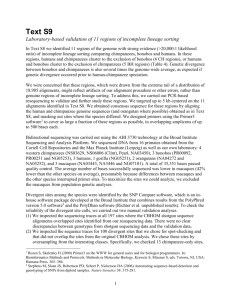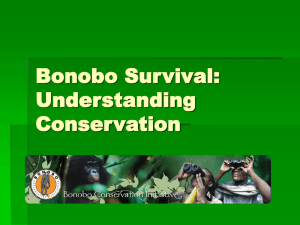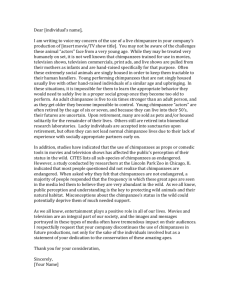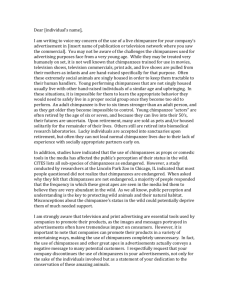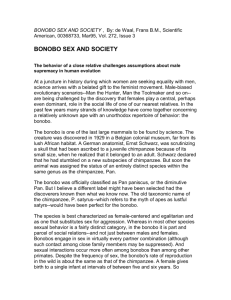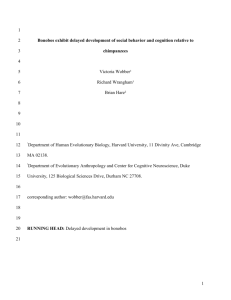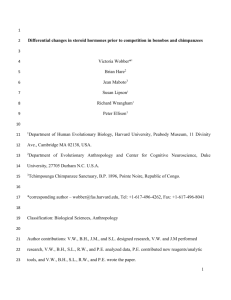Infanticide and Aggression in Chimps, Bonobos
advertisement
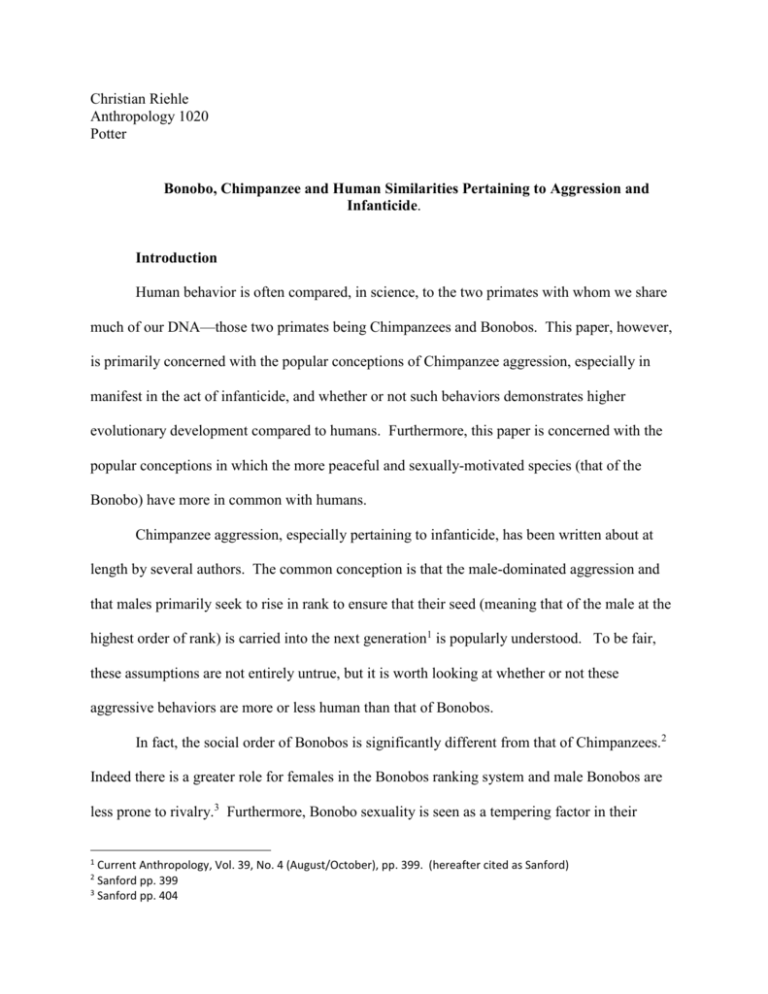
Christian Riehle Anthropology 1020 Potter Bonobo, Chimpanzee and Human Similarities Pertaining to Aggression and Infanticide. Introduction Human behavior is often compared, in science, to the two primates with whom we share much of our DNA—those two primates being Chimpanzees and Bonobos. This paper, however, is primarily concerned with the popular conceptions of Chimpanzee aggression, especially in manifest in the act of infanticide, and whether or not such behaviors demonstrates higher evolutionary development compared to humans. Furthermore, this paper is concerned with the popular conceptions in which the more peaceful and sexually-motivated species (that of the Bonobo) have more in common with humans. Chimpanzee aggression, especially pertaining to infanticide, has been written about at length by several authors. The common conception is that the male-dominated aggression and that males primarily seek to rise in rank to ensure that their seed (meaning that of the male at the highest order of rank) is carried into the next generation1 is popularly understood. To be fair, these assumptions are not entirely untrue, but it is worth looking at whether or not these aggressive behaviors are more or less human than that of Bonobos. In fact, the social order of Bonobos is significantly different from that of Chimpanzees.2 Indeed there is a greater role for females in the Bonobos ranking system and male Bonobos are less prone to rivalry.3 Furthermore, Bonobo sexuality is seen as a tempering factor in their 1 Current Anthropology, Vol. 39, No. 4 (August/October), pp. 399. (hereafter cited as Sanford) Sanford pp. 399 3 Sanford pp. 404 2 collective social order, making them less aggressive and less prone to violence4–demonstrating a more advanced sense of social order and intelligence. The understanding of superior Bonobo cognition is worth inspecting. In fact, studies have shown that Bonobos have a less developed cognition compared to Chimpanzees. To combat another misconception, Bonobo tendencies for sharing and lack of rivalry are manifestations of that lower cognitive ability. Likewise, Bonobos seem to demonstrate more juvenile attributes, both cognitively and socially, well into adulthood.5 This delayed social and cognitive ability in development demonstrates that Chimpanzees are clearly more like humans than Bonobos, due to the Chimpanzee potentiality of greater social maturity and cognitive development. Furthermore, Bonobo sexuality is more than likely overstated as a result of studies done in captivity which potentially skew socio-sexual results— potentially overestimate sexual encounters outside of regular mating periods.6 It is worth adding here that higher orders of cognition seem to be the better standard for evolutionary development. Infanticide: The greater potential for the act of infanticide among Chimpanzees is documented if not potentially overestimated by studies done in captivity.7 Yet the reasons for the act of infanticide and the results in population stability and growth are also worth examining. In fact, there is evidence that Human development of monogamous relations was a more pragmatic result of guarding against the population threatening results of infanticide. In fact, monogamy takes place in primate at a much higher rate than other mammals, potentially due to a greater brain size 4 Sanford pp. 399 Current Biology. 20. 226-230, February 9, 2010. pp. 227 (hereafter sited as “Webber”) 6 Sanford pp. 404 7 Sanford pp 400 5 resulting in greater cognitive potential.8 Yet, as stated earlier, cognitive potential is not the primary factor determining whether or not a species resorts to infanticide.9 In the case of another ape that has less DNA in common with humans there are few (possibly no) cases of infanticide among males but at least a handful of cases among females. Orangutans are arguably less advanced cognitively than Chimpanzees and Bonobos, yet just as in the case of Chimpanzees, population strength and pragmatism are at the hypothetical motive for resorting to such an act.10 In the case of humans, moving away from the act may have been more about humans demonstrating a degree of population-directed pragmatism. Thus, human movement away from the act may have had more to do with the helplessness of the human baby, and the potential for population-related impacts than a result of higher cognitive ability. Yet, there seems to be at least be some evidence that humans at some point chose monogamy in response to the act as an act of population stabilization.11 In other words, the action of humans and Apes (especially great apes) the instinctive adapt to socially accept or reject to infanticide has little relation to cognition or social maturity. The action, or inaction, in response to infanticide is a product of population strengthening or stability. The proof of this last claim is simply manifest in the population samples and ability of a species to adapt and grow, with or without infanticide. The success of humans to adapt and grow is quite evident in the world population. Yet, in spite of Bonobos and Chimpanzee being under stress, we can still get a glimpse of the population before they were threatened. In fact, Chimpanzee populations have potentially faced greater stress than that of Bonobos, yet Chimpanzee populations are significantly larger than their great ape counter-part, with 8 Science Magazine. Michael Balter. July 29, 2013. (hereafter sited as “Balter”) Webber pp. 228 10 Behavioral Ecology Sociobiology Review. July 1, 2009. Pp. 1549, 1553 (hereafter cited as “Beadrot”) 11 Balter 9 infanticide being a regularly practiced act.12 Meanwhile, Bonobos live in much more report places, demonstrating a lack of adaptability. Their population, while under threat as well, is still dramatically smaller than that of Chimpanzees13 (and Orangutans have greater numbers than Bonobos as well). Conclusion The popular conception of Bonobos being the peaceful, hypersexual and more advanced species of the two great apes which share the highest degree of DNA with humans seems to unsupported by the evidence. Cognitively, culturally, in simple measurements of adaptability, and relative population stability, the results (as current studies indicate) certainly give Chimpanzees the proverbial upper-hand. While humans have pragmatically discarded the act of infanticide and Chimpanzees have not, in many other measures Chimpanzees and Humans have much more in common compared to Bonobos and Humans. While it has often been argued that humans would do well to learn from Bonobos, the evidence indicates that Humans would be better served to learn from the species more like themselves. . Ultimately, perceived human-like actions in Bonobos, such as sexual enjoyment and affection and a wish to see the more peaceful nature as human-like, do not demonstrate greater evolutionary similarity to humans—especially when cognition and population adaptability are considered. From an evolutionary standpoint, the more aggressive of the two great apes discussed here is demonstrating much greater evolutionary adaptability. This could potentially lead future discussions to center more around how the more peaceful, hyper-sexual great ape (that of Bonobos) became a result of the harsher side of natural selection 12 13 WWF. Micheal Gunther. Chimpanzees Wildlife.org. Bonobos. Works Cited Balter, Michael. "Monogomy May Have Evolved to Protect Against Infanticed ." Science Magazine, July 29, 2013: 1-3. Gunther, Michael. Chimpanzees. 2013. http://wwf.panda.org/what_we_do/endangered_species/great_apes/chimpanzees/ (accessed August 4, 2013). Lydia H Beuadrot, Sonya M. Kahlenberg, Andrew J. Marshall. "Why Male Oragutans do not Kill Infants." Behavioral Ecology Sociobiology Review (Springerlink.com) 63 (July 2009): 1549-1562. Stanford, Craig B. "The SocialBehavior of Chimpanzees and Bonobos: Empirical Evidence and Shifting Assumptions." (Current Anthropology) 39, no. 4 (August/October 1998): 399-420. Victor Wobber, Richard Wranham and Brian Hare. "Bonobos Exhibit Delayed Development of Social Behavior and Cognition Relative to Chimpanzees ." Current Biology (Elsevier Ltd) 20 (February 2010): 226-230. wildlife.org. 2013. http://worldwildlife.org/species/bonobo (accessed august 4, 2013).
